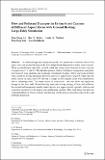Flow and Pollutant Transport in Urban Street Canyons of Different Aspect Ratios with Ground Heating: Large-Eddy Simulation
Author(s)
Li, Xian-Xiang; Koh, Tieh-Yong; Britter, Rex E; Norford, Leslie Keith; Entekhabi, Dara
Download10546_2011_Article_9670.pdf (1.064Mb)
OPEN_ACCESS_POLICY
Open Access Policy
Creative Commons Attribution-Noncommercial-Share Alike
Terms of use
Metadata
Show full item recordAbstract
A validated large-eddy simulation model was employed to study the effect of the aspect ratio and ground heating on the flow and pollutant dispersion in urban street canyons. Three ground-heating intensities (neutral, weak and strong) were imposed in street canyons of aspect ratio 1, 2, and 0.5. The detailed patterns of flow, turbulence, temperature and pollutant transport were analyzed and compared. Significant changes of flow and scalar patterns were caused by ground heating in the street canyon of aspect ratio 2 and 0.5, while only the street canyon of aspect ratio 0.5 showed a change in flow regime (from wake interference flow to skimming flow). The street canyon of aspect ratio 1 does not show any significant change in the flow field. Ground heating generated strong mixing of heat and pollutant; the normalized temperature inside street canyons was approximately spatially uniform and somewhat insensitive to the aspect ratio and heating intensity. This study helps elucidate the combined effects of urban geometry and thermal stratification on the urban canyon flow and pollutant dispersion.
Date issued
2011-11Department
Massachusetts Institute of Technology. Department of Architecture; Massachusetts Institute of Technology. Department of Civil and Environmental Engineering; Massachusetts Institute of Technology. Department of Urban Studies and PlanningJournal
Boundary-Layer Meteorology
Publisher
Springer Netherlands
Citation
Li, Xian-Xiang, Rex E. Britter, Leslie K. Norford, Tieh-Yong Koh, and Dara Entekhabi. “Flow and Pollutant Transport in Urban Street Canyons of Different Aspect Ratios with Ground Heating: Large-Eddy Simulation.” Boundary-Layer Meteorology 142, no. 2 (November 16, 2011): 289–304.
Version: Author's final manuscript
ISSN
0006-8314
1573-1472